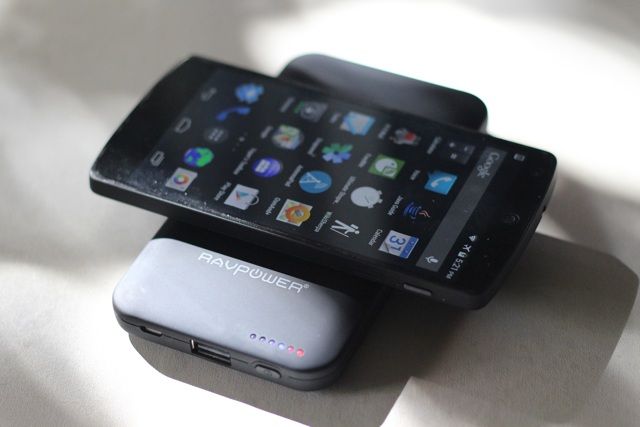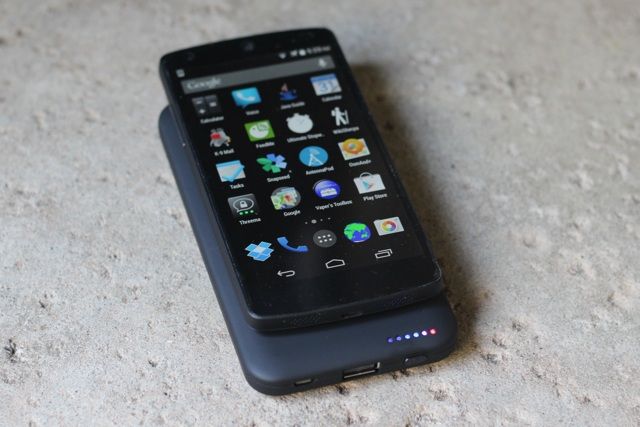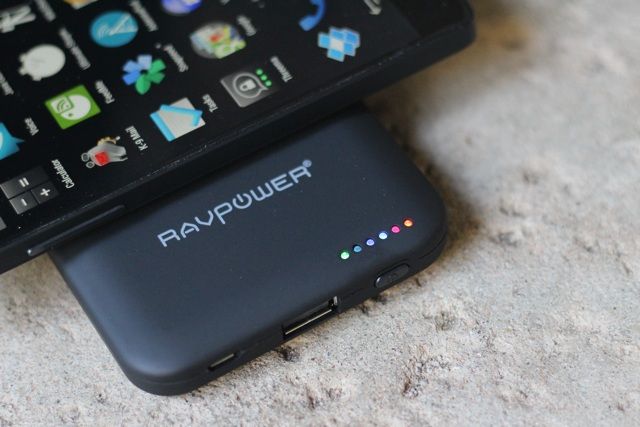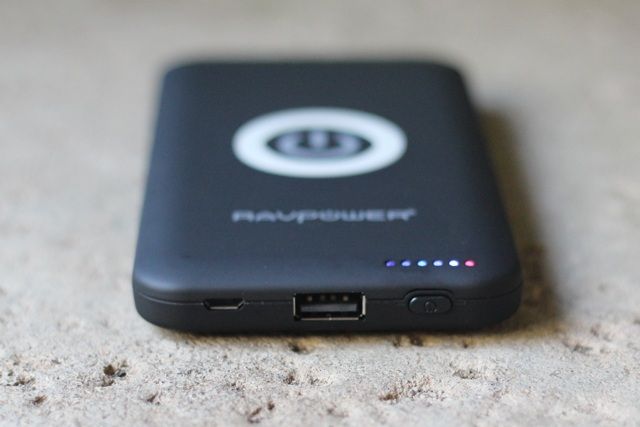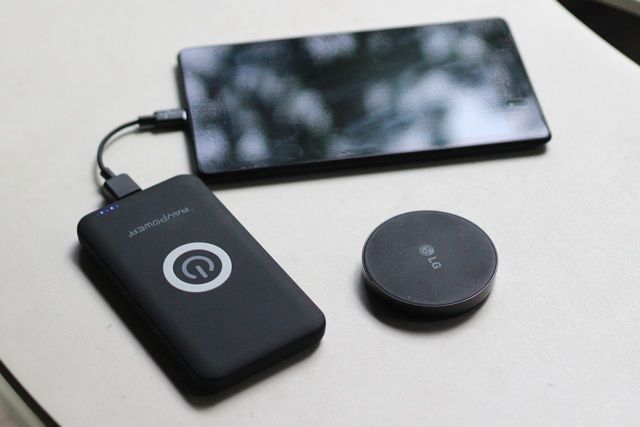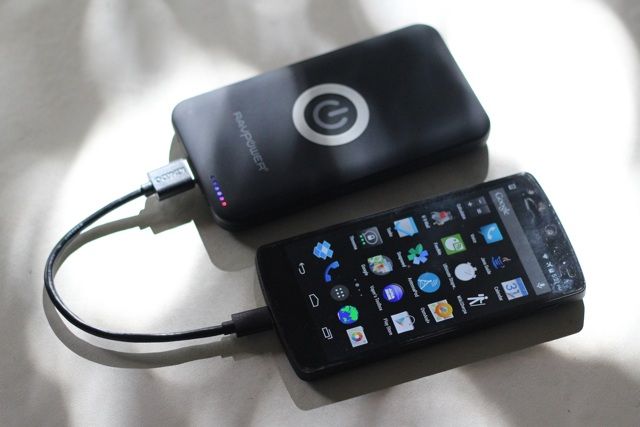RAVPower RP-WCN11 Wireless Power Bank
The $54.99 RAVPower RP-WCN11 provides a portable means of powering your gadgets — and it includes wireless, inductive charging using the Qi standard. It works with any device compatible with the Qi standard, such as the Nexus 7 and 5. To my knowledge, no similar power bank exists, however around the 5,000 mAh power bank market segment, there's the $39.89 Vaas VM50, which offers dual output ports. Generic Qi-chargers, on the other hand, run for around $20 on Amazon, although they lack the WCN11's efficacy and added features. In terms of pricing, it's more in line with the $68 8,000 mAh Kinkoo Infinite One, which we reviewed. If you want a wider range of mAh ratings, check out our list of the six best backup batteries around.
So does the RAVPower WCN11 overpower its competition or does it run out of juice?
Design and Specs
Rectangular in design, and about the size of a Nexus 5 smartphone, the WCN11 looks svelte and sexy. It's composed entirely of soft, black matte plastic, with rounded edges and a wireless charging pad positioned in its center. Wireless charging, known by its trademarked name "Qi", is one of two major competing wireless charging standards. While Qi is an open-standard, Duracell's Powermat technology remains closed. Wireless charging in general remains a tricky affair, with frequent repositioning of your device over the charging cradle.
The WCN11's 13.6 x 7.5 x 1.4 cm dimensions make it slightly bulky, although portable enough to fit in a pocket or purse. It felt a little on the uncomfortable side in my jean's front-pocket. But in a backpack, purse or desk, it fits easily. For comparison's sake, the size makes it slightly larger than a 5.5-inch smartphone. Most phones will line up precisely with the charging pad. A tablet on the other hand, covers the entirety of the WCN11.
Note: I couldn't ascertain the manufacturer of the battery module itself. I briefly attempted using a pry-tool, but aborted after noticing that the soft, matte plastic exterior seems prone to scratches. Other RAVPower devices are known to use Samsung-branded batteries, so I assume this is also the case with the WCN11.
Specifications
- 4,800 mAh battery
- Wireless Qi charging
- 5V USB output
- 5V microUSB input (took me over 8 hours to fully charge)
- Power button
Living With the RAVPower RP-WCN11
The RAVPower WCN11 remains the only power bank that actually worked, without overheating, with a short-length charging cable. Because shorter length cables provide less resistance and attenuation, you get more "bang for your buck" – or, more accurately, more bang for your mAh. Many battery packs lose a substantial amount of their rated mAh while charging devices – the longer the cable, the greater the loss. For example, a 5,000 mAh battery with a long charging cable might only provide around 4,000 mAh to your devices. Using a short cable will maximize the amount of power received by your devices. Unfortunately, shorter length cables can also cause overheating and damage to your devices. Of the half dozen batteries that I've tested, only the RAVPower WCN11 reliably charged over the short length cable.
On the 2013 Nexus 7 and the Nexus 5, the RAVPower WCN11 charges at around 15-18 mAh per minute (this is expected at its amperage). Using the short length cable, I get around 4,200 mAh (actual: 4,198) out of the WCN11. That means a loss of around 600 mAh, or 12.5% — however, keep in mind that cable quality also plays a role in battery efficiency. Poor quality cables can cause substantially decreased mAh loss, relative to high quality ones.
Wireless Qi Charging
A big problem with wireless charging is detection radius. Users often find themselves fidgeting with the device in attempts to get wireless charging working. This is a tremendous negative on my LG-branded Qi charger, which offers a relatively small detection zone. Fortunately, the detection range of the RAVPower WCN11 is quite large and devices don't slip. It employs a circular silicone rubber pad to prevent shifting of the smartphone. Smartphones and tablets also get detected quickly. After placing a Qi-enabled device on the pad, the charger emits an audible beep. This feature will prove useful for those experiencing difficulty finding the sweet-spot where devices charge properly.
Note that a major weakness of wireless charging is its efficiency. If users jacket their smartphone or tablet in a case, it will further reduce the available electric charge (mAh) from the power bank. I found that something as simple as a case or skin reduced total electric charge by around 50% — although technically speaking, wireless charging is strictly less efficient than using a short-length cable. Most users will squeeze something in the ballpark of around 2,400-3,000 mAh out of the WCN11, when charging wirelessly. When I put the WCN11 to the test, using a jacketed Nexus 7 and Nexus 5, I received a total of 2,528 mAh (estimated) before its battery ran dry. That's a tremendous loss of electric charge – however, since the WCN11 comes with a micro-USB charging cable, there's little reason to use the Qi feature on-the-go.
Users will want to use the wireless charging feature as a "pass-through". Most chargers can't actually plug-in and "pass-through" a charge to devices. The WCN11 proves the exception to this rule, as it charges devices even when the battery is drained, if plugged in. I'm unaware of any power bank offering similar functionality, as most won't charge itself and another device through a wired connection, simultaneously. I've read that the WCN11 isn't a true pass-through, but that it managed to charge while drained, suggests otherwise.
In short, if you need a Qi-charging device, the WCN11 ranks among the best on the market for its functionality and flexibility.
Portability
The WCN11 specializes in a dual-use role. You can either use the cable to charge your devices or from a flat surface, recharge without cables. I do not advise using the WCN11 as a Qi-charger on-the-go, as it loses a great deal of efficiency while charging through its Qi-function. Also, if you use a case in combination with the RAVPower, it will lose about 50% of its battery's rated charge.
Irritations
The RAVPower WCN11 suffered from two minor shortcomings – first, the LED charge status indicators do not accurately measure the battery's total life. Although there's six LED lights, the WCN11 will only display three potential power states: Full, mostly full and mostly drained. The second shortcoming is that the lights stay on even after the WCN11 ceases to provide a charge. A chronic bug causes the LED light to infrequently remain lit after discharging the WCN11.
I do appreciate that the WCN11 doesn't fully discharge – complete discharging of a device causes some damage to lithium-ion batteries, particularly if you leave the battery empty for prolonged periods of time. Even so, it's an irritation that the LED lights don't disengage once charges cease, as this may lead to accidental total discharge.
Conclusion
RAVPower's RP-WCN11 wireless power bank is the only wireless backup battery around. It operates in two different modes: First, as a wireless Qi charging station and, second, as a 4,800 mAh power bank. Because it can function as a pass-through wireless charger and as a portable backup battery, compatible with short micro-USB cables, it's especially unique. The high price-point is justified through its simplicity and flexibility. You get a better deal by buying the WCN11 by itself rather than a backup battery and a Qi-charger, separately. If you don't own a Qi-enabled device, or already own a Qi-charger, there's no reason to buy the WCN11 at its price-point.
[recommend]If you're in the market for both a wireless charger and a portable backup battery, buy it. If you need just one or the other, you might still benefit from the WCN11's high quality construction and ease of use, but around $50, first consider other options.[/recommend]


